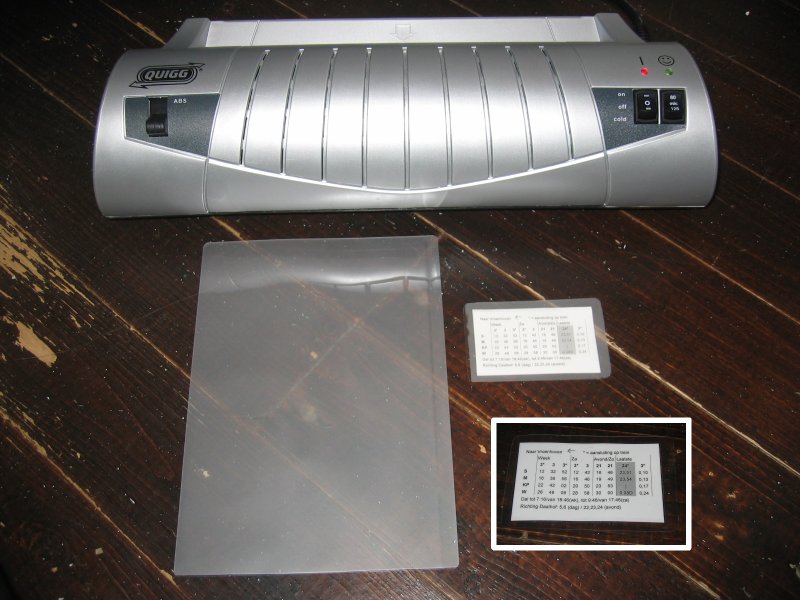
Rating of the best laminators for 2025
Lamination is used to preserve documents, photographs and other paper media of importance. Previously, this method was used only in the printing house, but now it is used in all firms and even at home.
Content [Hide]
What is a laminator and why is it needed
The first laminators were large machines that were used only in industrial production.About 20 years ago, manufacturing companies began to develop more compact models that would be suitable for use in companies and not only.
So, laminators are a special technique that covers paper with a transparent film that retains the contents for a longer time. Thus, the surface of the paper carrier is protected from external factors, such as liquids, mechanical stress, and much more.
Types of laminators
There are many laminators on the market, but they are all divided into several types:
- rolled, such are used in the processing of bulk surfaces and a large number of products, as a rule, they are used in printing houses, advertising agencies and other similar organizations. Such machines take up a lot of space and use roll film;
- batch, have a more compact size suitable for small printing houses, offices where the flow of documents for lamination is not large. In such devices, packages of the required format (A2,3,4, etc.) are used; it is not cut to reduce the format, but the appropriate size is selected from the products provided.
Since rolled ones are intended for large-scale production, they most often use batch ones, the dimensions of which allow them to be used even at home.
Pros and cons
When choosing one or another type of laminator, the buyer should consider their positive and negative sides:
- rolled, the pluses include the ability to cover sheets with a format from 0A to 3A, such devices also have high productivity and are equipped with special heating rollers, which allows you to achieve excellent quality when laminating.For such devices, very thin films are produced, starting from 8 microns, and the consumable material itself is much cheaper. The negative aspects include the complex design of the machine, dimensions, and not everyone has the possibility of one and two-sided coating, and qualified specialists are required to manage them;
- package also have a number of pros and cons. The positive aspects include accessibility, ease of use, the presence of the function of one-sided and double-sided lamination, the temperature and paper feed speed are adjustable, covers surfaces with sizes from A3 to A6. Negative indicators include the high cost of the material and the fact that they are not intended for permanent use. The size of the laminated sheet depends on the type of device, and one-sided lamination is possible only when using special packages.
As you can see, each type has both pros and cons, which can play a significant role when choosing a model.
What to look for when choosing
Before purchasing a device, it is worth considering a number of working points, such as:
- what type and thickness of coating will be used;
- paper weight and dimensions;
- volume of laminated products;
- How often will the machine be used?
- the presence of the function of automatic shutdown, protection against overheating, temperature control;
- the presence of additional features, for example, glossing, matting.
It is also worth paying attention to how the film will be glued, there are two options:
- hot, in this case the coating melts on contact with the heating element and under pressure firmly adheres to the surface of the paper, thus ensuring high-quality lamination;
- cold, intended for paper surfaces that cannot withstand high temperatures, in this case the film is attached due to cold glue and the pressure exerted by the rollers.
There are types of devices that can process documents in both ways, but their cost is much higher than those with only one option.
Types of films
The appearance of the document after coating will be affected by the type of film that is selected. There are several options:
- glossy, used in the processing of photographs, various illustrations, posters, as well as for book covers. Gloss emphasizes the color, but if there is a small print, then such a film will make it merge and therefore it is not suitable for documents with text;
- matte, used for application on business cards, certificates, certificates and other important papers, such a coating does not create glare and facilitates the visual perception of the text;
- textured, suitable for processing book covers, paintings, with the help of such a film it is possible to imitate fabric surfaces, wood, create the effect of splashes and patterns, and much more.
In addition to the appearance, such coatings are also distinguished by thickness, rigidity and the ability to pass air. Such differences also affect its cost.
Specifications
Before purchasing, you should also pay attention to the technical characteristics of the selected device:
- how many shafts are installed, the more of them, the better the lamination process will be, since it is these parts that are responsible for pressing the film to the paper. The cost of the device also depends on the quantity;
- the speed of the procedure, it can be from 15 to 2000 cm per minute, that is, the higher it is, the greater the performance;
- what paper size can handle;
- the thickness of the paper that the machine can process;
- coating thickness, which is provided for the model;
- the period during which the elements are heated;
- What material is the case made from?
Another important function is cold lamination, which allows the use of a coating with an adhesive base that does not require heating.
Additional options
More expensive models are equipped with a number of additional features that simplify the workflow:
- reverse, an option that makes it possible to turn the shafts in the opposite direction, it is very convenient if a sheet is wound on one of them, if it is available, it will not be necessary to disassemble the machine in order to remove it;
- photo lamination, not every model has a similar function;
- the presence of a regulator that allows you to control the temperature, they are automatic or manual;
- speed switch, allows you to independently adjust the speed of the machine;
- the ability to release sheets in case they are skewed during lamination;
- the presence of a cooling system allows you to quickly cool the heated elements;
- Sleep Mode is a convenient feature that helps you save electrical energy;
- Safe Start option that automatically determines the appropriate lamination mode based on the surface;
- Auto Shut off automatically turns off the device if it is not used for a long time.
Quite a few models are equipped with special legs that allow you to wind the network cable for easy storage, as well as handles for moving the machine.
Rating of the best laminators for 2025
A fairly large selection of laminators is provided for users, they have a variety of additional functions, sizes, which allows you to choose a more suitable model. Among the products provided, a list has been compiled, which, according to the owners, includes the best models. In most cases, appliances are divided into those that are suitable for the home and those that are suitable for small and medium-sized businesses.
For home use
In general, models suitable for use at home or small offices are medium-sized machines that are suitable for infrequent use and allow coating of small formats.
DELI E3894-EU
votes 29
This model is produced by a large Chinese company, which is also engaged in the manufacture of stationery. The device is suitable for work not only at home, but also in the office and allows you to cover A3 formats with film. It has a low cost and average power, there are restrictions on the density of processed materials, it should not exceed 0.6 mm, the film thickness can vary from 60 to 200 mm. The case is made of high-quality plastic, in addition, an overheating sensor and a reverser are installed.

- suitable for a non-specialized office;
- can laminate sheets up to A3 size;
- quickly ready for work;
- price.
- do not recommend using more than 10 times a day.
Brauberg L460
votes 15
One of the most budgetary models that allow you to laminate A4 sheets, it is easy to use and small in size.The gluing of the film is carried out in a hot way, with regard to the thickness of the applied material, it can reach 125 microns, and the speed is 30 cm per minute. One of the main disadvantages is considered to be slow warming up for work, and therefore the model is perfect only for use at home.
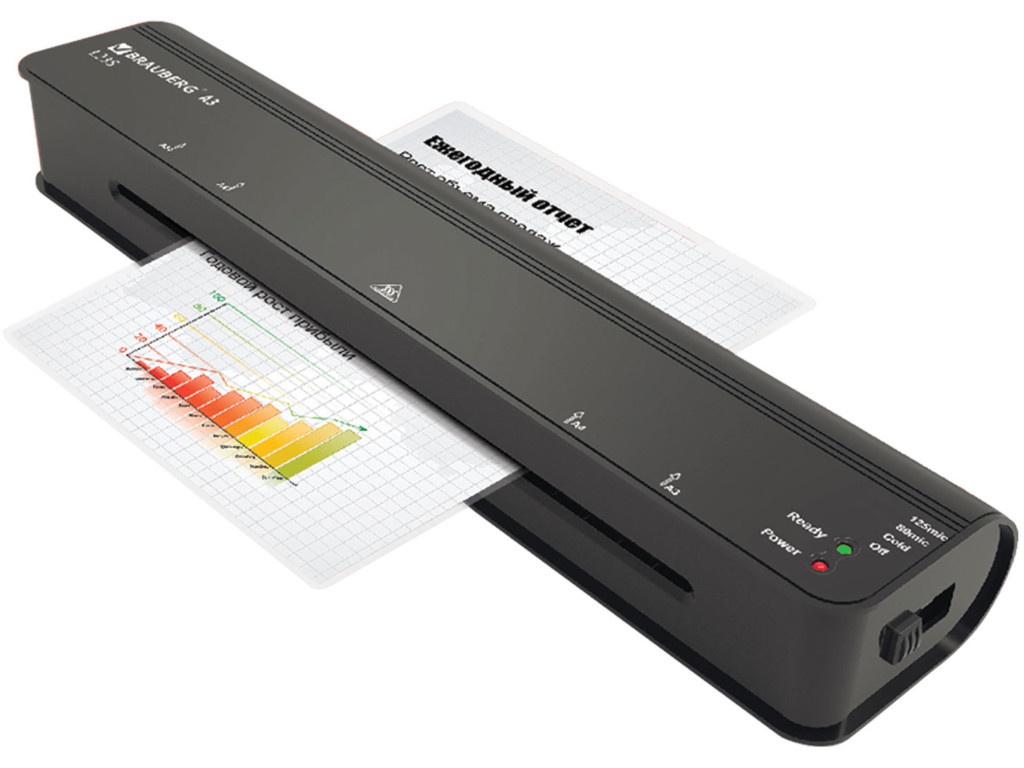
- inexpensive;
- easy to use;
- the maximum size of the processed surface A4;
- there is a heating indicator;
- allows the use of thick film.
- takes a long time to warm up to working condition.
Office Kit L2305
votes 35
An excellent model, originally designed for office use. The device copes with a decent amount of work and quite quickly, but the preparation process, that is, the heating of the elements, lasts about 5 minutes, which is quite a long time. For work, a film with a thickness of 75 to 125 microns is used. Among the additional options, one can single out the possibility of cold lamination, an indicator of readiness for work. The design of the model is so simple that it can be easily disassembled if the processed sheet is jammed.
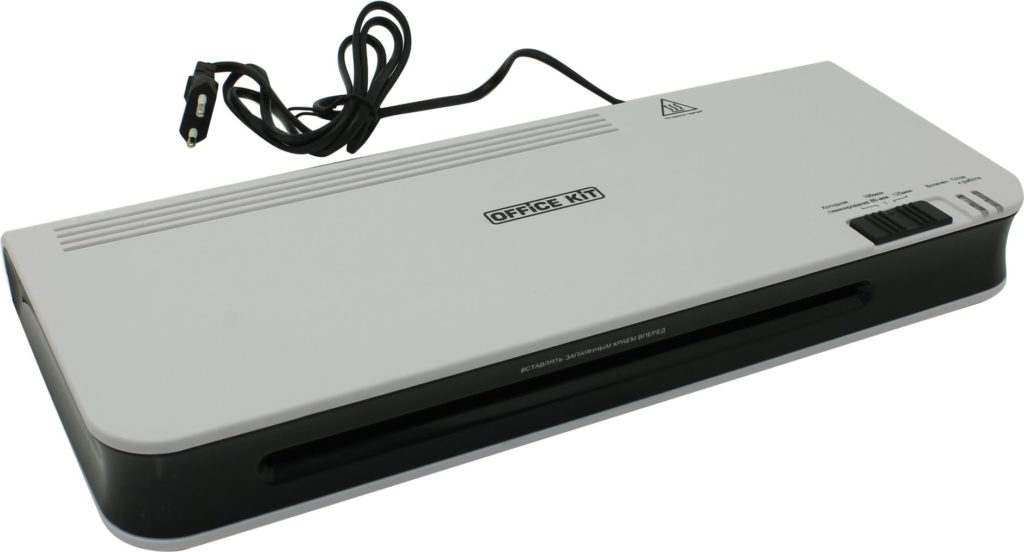
- price;
- performance;
- suitable for the use of various materials;
- film of different thickness is suitable;
- built-in several modes of operation (cold, hot lamination).
- heats up slowly
- the legs of the model are rather low, which may cause the device to overheat) it is required to install it on a stand);
- after heating, a slight smell appears.
Geha A4 Basic
votes 6
Another device made of high-quality plastic, which is perfect for infrequent use at home.The heating time can take from 3 to 5 minutes, there is a cold lamination mode, and packages with a thickness of 80 to 100 microns are suitable for gluing. Also, this model has a button that allows you to stop the operation of the shafts at any time and a ready-to-work lamp. This unit does not have a cooling function and is therefore not suitable for long-term use.

- not expensive and compact;
- can work with photos;
- There is cold lamination.
- no cooling system provided;
- no reverse function.
GLADWORK jLAM Full
votes 8
Small size bag laminator suitable for home use or small office. The model is qualitatively assembled, the case is made of high-quality heat-resistant plastic. At the bottom is a panel with five modes of operation. After switching on, the device quickly warms up to working condition, has a high power (850 W) and a capacity of up to 300 mm per minute. The model can work with a film thickness from 60 to 250 microns.
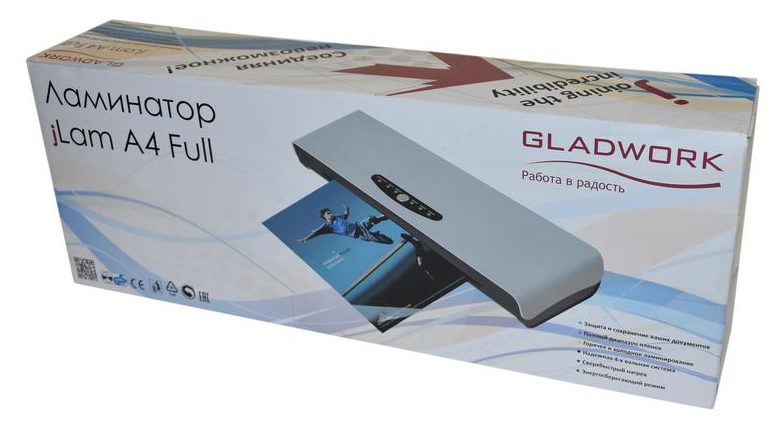
- quality processing;
- fast heating to working condition;
- compact dimensions;
- long service life.
- the cost is higher than similar models.
Fellowes Lunar+ A4
votes 19
Lightweight device with small dimensions allows you to work with sheets, the size of which reaches A4. It takes about 4 minutes to warm up to a working state, after readiness, a green light indicator lights up on the body, and a lever is provided that opens the shafts so that you can pull out the sheet if necessary.This model allows you to use film from 75 to 130 microns and can process up to 20 sheets per day, which allows you to use it not only at home, but also in a small organization.
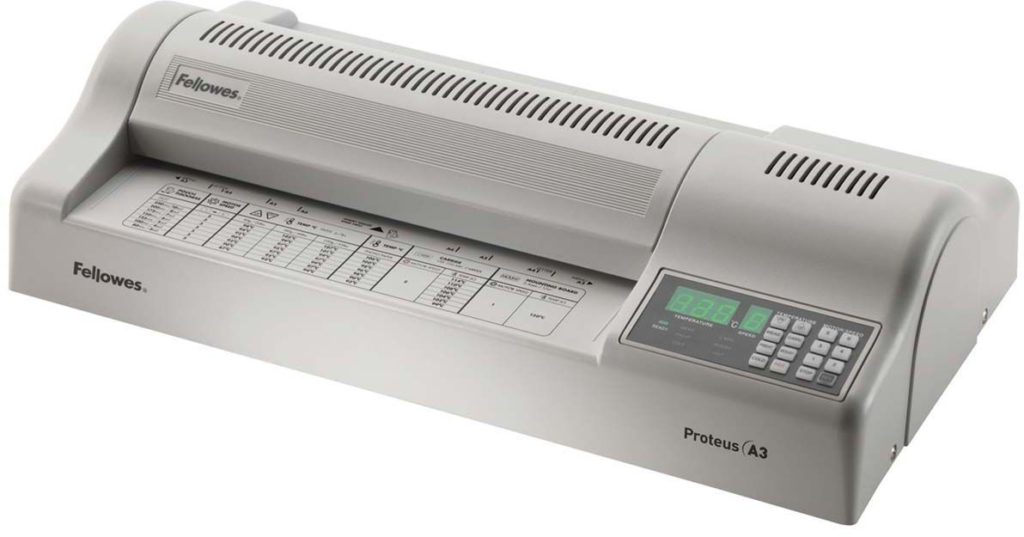
- price;
- easy to use;
- quality assembly;
- long period of operation;
- It does not require special care.
- If used for a long time, an odor may occur.
For business
More powerful models that can withstand the load for a long period. The cost of such machines is sometimes significantly different from those that are suitable for everyday use.
Pingda PD FM-360
votes 6
Professional roll laminator, small in size and easily placed on the table, allows you to apply the film both one-sided and two-sided, cold and hot. The lamination speed is 1.8 meters per minute, which is a good indicator, which makes it possible to work with a large volume of products. The kit includes 2 silicone shafts with manual clamping and a film cutter. The maximum width of the roll is 360 mm, and the diameter is 340 mm, for the convenience of using rolls of maximum length, special holders are built into the device, and there is also an option to turn off the heating of the lower roll. High performance, small size and inexpensive consumables make the device ideal for working in a printing house or other printing organization.
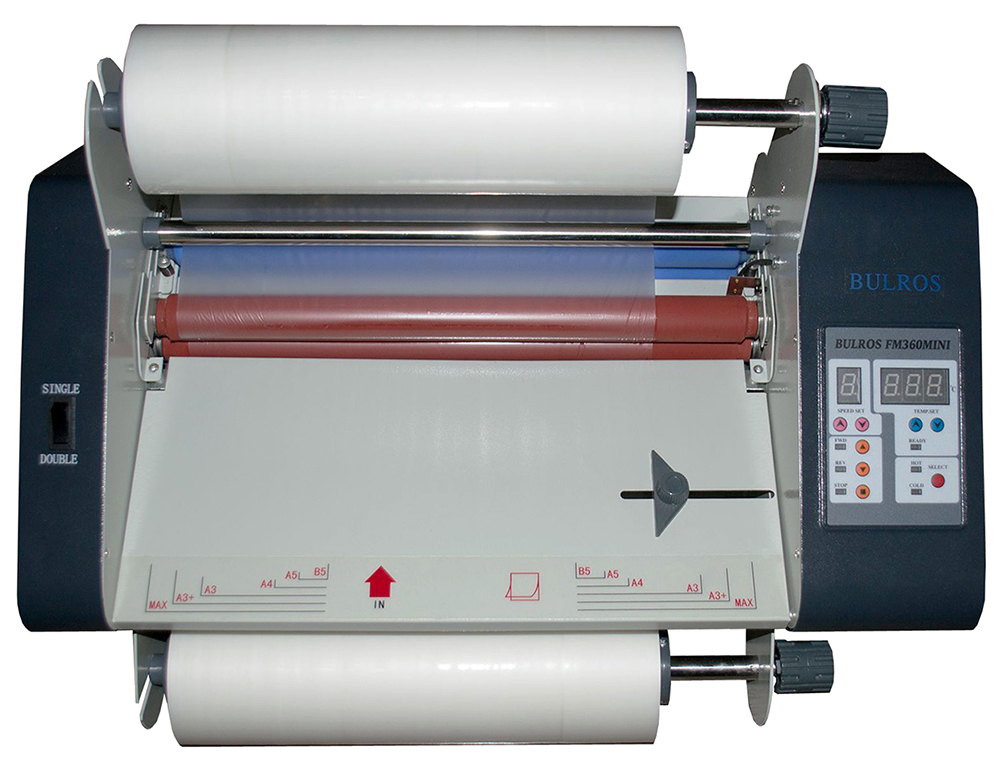
- excellent processing quality;
- fast speed;
- long period of service;
- inexpensive consumables;
- compact.
- to work on it will require special skills.
Buro SUPER-336
votes 3
The Buro SUPER-336 model laminator is perfect for copy centers, photo studios, printing houses with a small circulation.Its metal body is assembled in such a way that, if necessary, it easily opens access to the 4 shafts located inside. It is equipped with a display showing the heating temperature, readiness for operation, as well as a button for controlling the reverse and infrared heating of the shafts. Heating to the desired temperature takes three minutes, and the area that the device handles in a minute is 560 mm, the consumable material is a film with a thickness of 60 to 250 microns. The technique is easy to use and does not require additional knowledge in order to fully use it. There is a drawback with which you should be careful, the metal case of the device gets very hot, but the provided cooling system quickly copes with the problem.
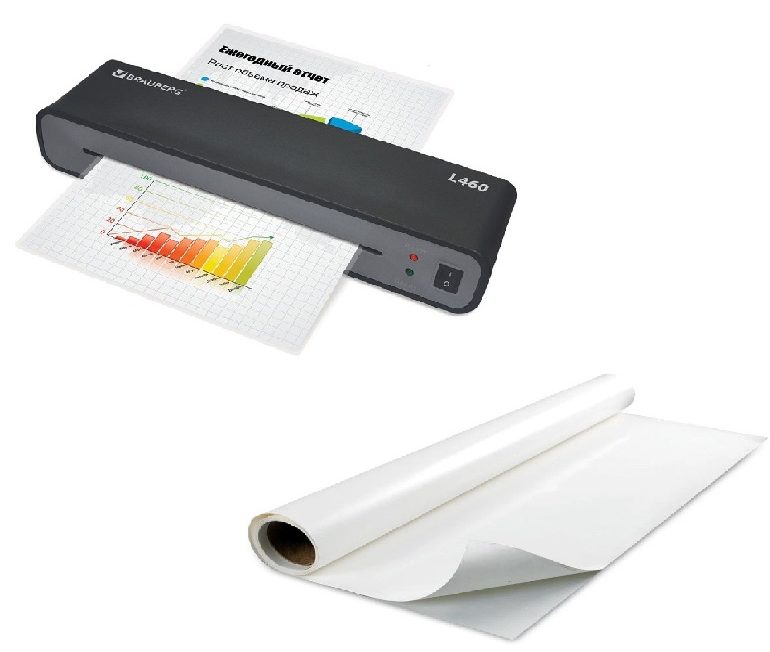
- modern design;
- quality assembly;
- operation does not require special skills;
- quick preparation for work.
- works with formats up to A 3 inclusive;
- case gets very hot.
GBC Fusion Plus 6000L
votes 5
Another small package laminator that is perfect for office work. The external part of the device is equipped with a control panel, which allows, if necessary, to adjust the thickness of the package, there is a signal that notifies you of readiness for work and warns that the package is in the wrong position. But most of the function is set in automatic mode, for example, the device itself determines the desired thickness of the working material, turns on the reverse option if necessary, sets the temperature and speed of applying the film and automatically turns off in case of downtime.The maximum size of the coated surface cannot exceed A 3, and the thickness of the applied film varies from 75 to 250 microns. The machine warms up to working condition in one minute, and processes the maximum allowable area in 20 seconds.
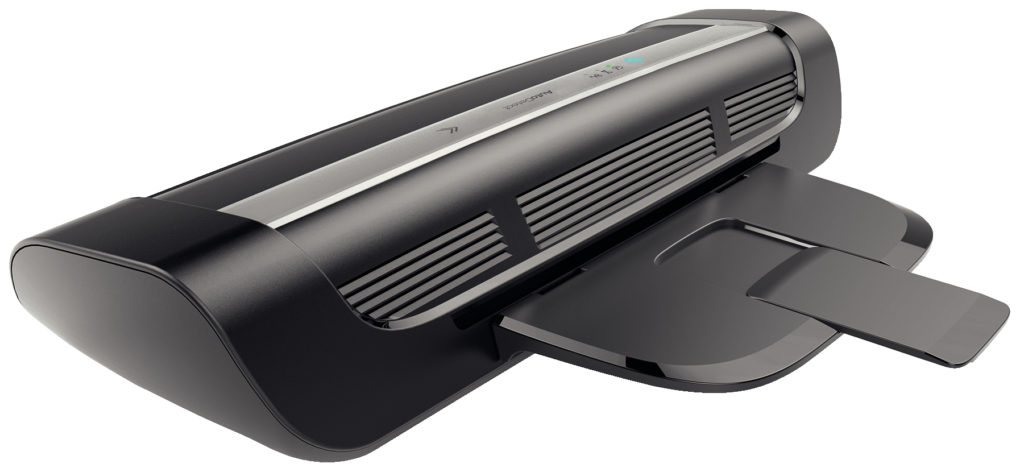
- stylish, modern design;
- small sizes;
- short warm-up time;
- and fast lamination;
- the case does not heat up;
- long service life.
- limited format of processed sheets;
- expensive device.
Fellowes Proteus A3
votes 10
An excellent laminator that allows you to process up to 100 sheets of sizes up to A3 per day, the heating rate is less than a minute, the coverage area is 1 meter per minute. 6 shafts are hidden under the body of the device, which provide uniform heating and high-quality polyethylene application, and the existing control panel allows you to set the desired temperature and speed. Film thickness from 75 to 250 microns is suitable for work. Despite the high quality of the products, Fellowes Proteus does not require special skills to work and therefore even a beginner can handle it.
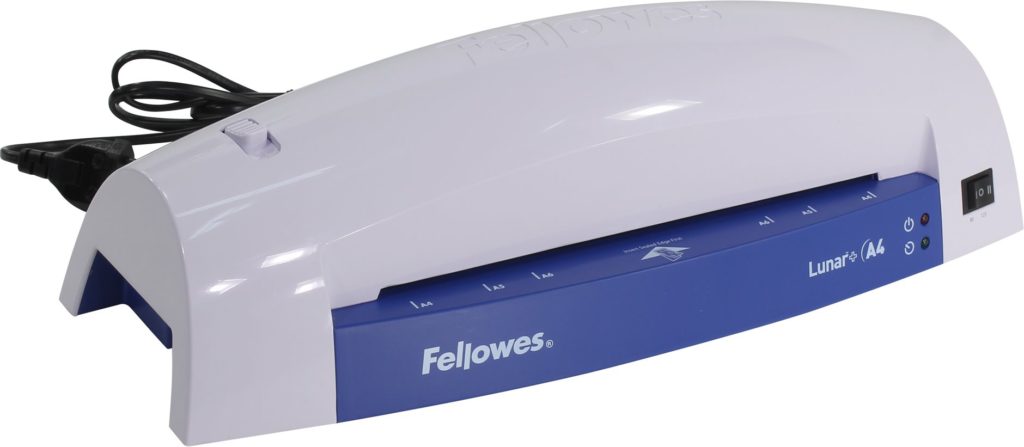
- fast and high-quality lamination;
- easy to manage;
- the presence of 6 shafts.
- limited dimensions of the surface to be coated (A3);
- high price.
GMP Photonex-SYNC 235
votes 3
One of the best devices of the semi-professional class, the case is made of high-quality hydrocarbon plastic, which does not overheat during operation. In addition, a forced ventilation system is provided, which allows you to protect the device from overheating during long-term operation.The design is equipped with a control panel that allows you to switch the sheet feeding speed and roller temperature manually or automatically. This machine has a continuous operation time of 4 hours, after which the equipment must be allowed to rest for about 45 minutes.
- resistant to overheating;
- long service life;
- product quality is very high.
- expensive.
Bulros FGK-320S
votes 4
The body of this device is made of metal, inside there are four shafts for hot lamination. The design of the model itself is simple, and does not require special skills and knowledge when working. On the front there is a display showing the heating temperature, turning on the reverse option. A cooling system is provided, but despite its presence, the body of the unit becomes very hot during long-term operation. In the work, you can use a coating material with a density of 60 to 250 microns. The device heats up quite quickly (3 minutes) to a working state and allows you to laminate the surface at a speed of 560 mm per minute. So, Bulros FGK-320S is a reliable and high-quality laminator model, which is perfect for small copy or photo centers, printing houses.
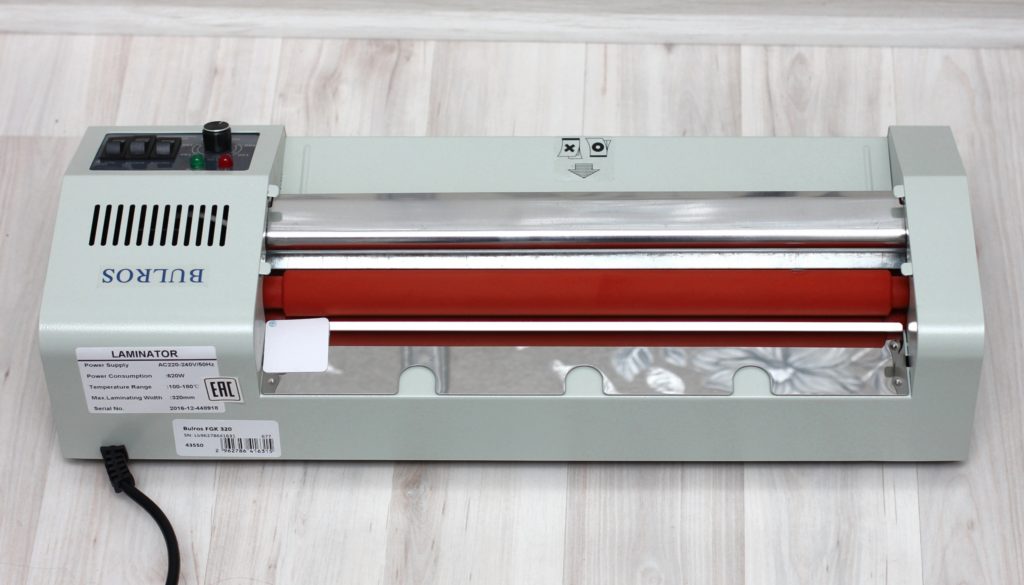
- price;
- the quality of the products received;
- device reliability;
- film heating speed;
- suitable for different materials;
- long period of service.
- with prolonged use, the case heats up;
- not suitable for large enterprises with a wide circulation.
If you are going to purchase a laminator, you should familiarize yourself with the characteristics of the device, as well as take into account the conditions in which it will be used.Since the models for the home and the printing house have quite significant differences not only in cost, but also in performance and quality.
Popular Articles
-

Top ranking of the best and cheapest scooters up to 50cc in 2025
Views: 131655 -

Rating of the best soundproofing materials for an apartment in 2025
Views: 127695 -

Rating of cheap analogues of expensive medicines for flu and colds for 2025
Views: 124522 -

The best men's sneakers in 2025
Views: 124039 -

The Best Complex Vitamins in 2025
Views: 121943 -

Top ranking of the best smartwatches 2025 - price-quality ratio
Views: 114982 -

The best paint for gray hair - top rating 2025
Views: 113399 -

Ranking of the best wood paints for interior work in 2025
Views: 110323 -

Rating of the best spinning reels in 2025
Views: 105333 -

Ranking of the best sex dolls for men for 2025
Views: 104370 -

Ranking of the best action cameras from China in 2025
Views: 102220 -

The most effective calcium preparations for adults and children in 2025
Views: 102014